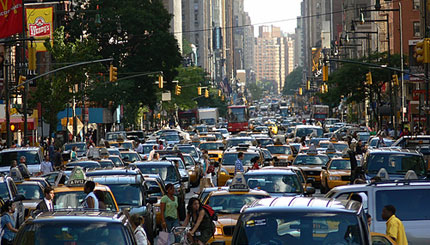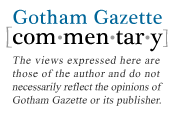
Last spring, when Mayor Michael Bloomberg proposed an $8 "congestion fee" to drive into parts of Manhattan, the plan fell victim to several intrinsic weaknesses. Geographical inequity, for one: Manhattan residents and New Jersey drivers would have ponied up a lot less than car commuters from Brooklyn, Queens and Long Island. Lack of ambition, for another: The promised 6 percent drop in midtown gridlock seemed a meager reward for ending free use of city streets and bridges.

But the basic idea is a good one, as experience in London, Stockholm and Milan has shown. Can "congestion pricing done right," as new State Sen. Daniel Squadron has called for, fix the Bloomberg plan's flaws? With a smarter plan, can we make a serious dent in traffic tie-ups that by some estimates cost the city $13 billion a year, while creating so many winners that the plan survives the legislative gauntlet?
What This Plan Would Do
Here's one possibility:
- Replace the mayor's flat $8 toll to drive into Manhattan south of 60th Street with a sliding scale of charges. All cars and trucks trips driving across 60th Street from the north or entering midtown or lower Manhattan via a bridge or tunnel would pay a fee, but it would vary, from $10 during weekday peak hours down to $2 at night and much of the weekend. The charge would be at least twice as effective in unsnarling traffic as the mayor's $8 flat fee yet would average less -- around $6.
- Since all vehicles contribute to congestion, all vehicles pay: no "offsets" for other tolls paid by drivers from New Jersey, no matter how much they paid to cross the Hudson, and no exemptions for "black cars" driven into Manhattan to pick up or drop off their largely well-off clientele. For medallion cabs, which circulate a great deal within the "cordon" without crossing it, a surcharge on fares gives an equivalent effect.
- Dedicate the revenues from the congestion toll and taxi surcharge to eliminate bus fares (which will speed boarding), make trips within the city on Long Island Rail Road and Metro-North commuter trains free (which will help ease subway crowding), and cut subway fares.
This plan originated with Ted Kheel, the lawyer and civic activist who, for the past two years, has sponsored a research program to realize his hope of making car travel more efficient and mass transit more affordable by integrating the two systems. Kheel's foundation, Nurture New York's Nature, has funded development of a computer model -- the "Balanced Transportation Analyzer" -- that predicts how the new tolls and fare incentives will alter commuter behavior and calculates the resulting changes in travel speeds and agency revenues.
The analyzer is firmly grounded in empirical evidence. For example, to calculate how many auto commuters would shift their trip from the 6 a.m. to 9 a.m. morning peak, when the $10 toll would apply, to the 5a.m. to 6 a.m. hour, when the toll would drop to $4, the analyzer draws on data about drivers' actual time-shifting after the Port Authority instituted time-variable pricing in 2001. The same approach lets us estimate that a variable subway fare topped off at $1.50 during the 8 a.m. to 9 a.m. and 5 p.m. to 6 p.m. rush hours and tapering down before and after would cut subway ridership during those two rush hours while increasing it at less crowded times.
The analyzer is now making the rounds of the regional transportation agencies. No less an authority than "Gridlock" Sam Schwartz, the former chief traffic engineer for New York City and the dean of his profession, has pronounced the model "comprehensive, logical and the best I've seen."
Run this new congestion-pricing plan through the analyzer, and the numbers are striking. Charge a 24/7 congestion price varying from $2 to $10 and increase taxi fares by a third, and the resulting revenue could allow the Metropolitan Transportation Authority to halve the average subway fare and make all other transit inside the city, including buses and commuter trains, free. The combined carrot and stick will increase the number of people traveling into the heart of the city while reducing the number of cars. This would improve daytime traffic speeds by an average of 20 percent in Manhattan south of 60th Street and provide sizeable improvements on the approaches from the boroughs and New Jersey.
To be sure, our plan won't cure the inherited MTA deficit. Other proposals have been advanced to do that, such as the one proposed by the Ravitch Commission last fall. A "Kheel-Komanoff" plan, however, could be powerfully merged with a deficit-plugging plan, enhancing it in crucial ways. Indeed, the Ravitch plan, which may be adopted in some form this spring, is fully compatible with our model. The small -- and controversial -- portion of that plan that calls for geographically biased bridge tolls would be replaced by the Kheel-Komanoff universal toll and taxi fee. (Note to residents east of the East River: Under the Ravitch plan, which calls for bridge tolls, alone, you would account for 60 percent of all fees collected. That falls to 36 percent under Kheel-Komanoff, which spreads the burden among more drivers.)
The merged plan could keep the payroll tax Ravitch recommends as well as his calls for greater efficiency and transparency at the MTA. If additional monies are needed to fund the authority's capital budget, these could be drawn from the congestion-pricing pot by deferring some of the drop in subway fares. The provision for free buses should be inviolate, however, because many poorer New Yorkers rely on buses and they are a mainstay in communities underserved by subways.
Our plan benefits everyone, including drivers, who will pay more but get a faster and more reliable commute in return. The biggest beneficiaries may be bus riders. The free fare will not only stretch their paychecks but also speed their trips, since no one will have to stop and swipe a Metrocard to get on board. New Yorkers would see overall time savings running into billions of dollars, not to mention fewer car crashes, healthier air and an improved quality of life.
Mayor Bloomberg, Governor Paterson, MTA Chairman Sander, fellow New Yorkers: That traffic plan you've been waiting for? It's right here.
Charles Komanoff, an independent policy analyst, is president emeritus of Transportation Alternatives and a founding trustee of the Tri -State Transportation Campaign.